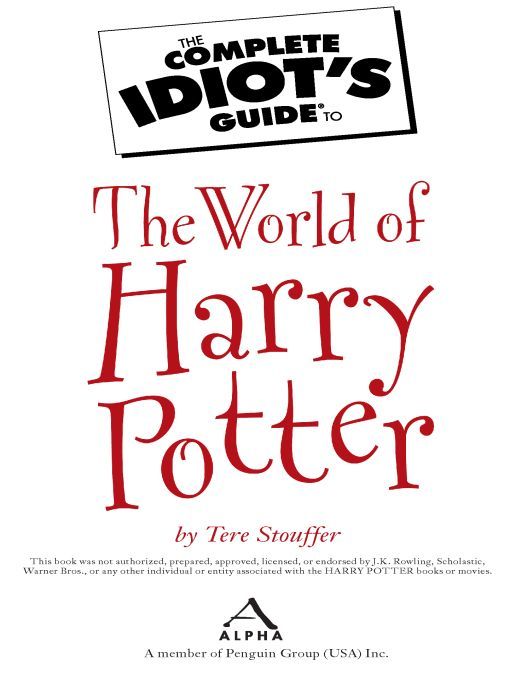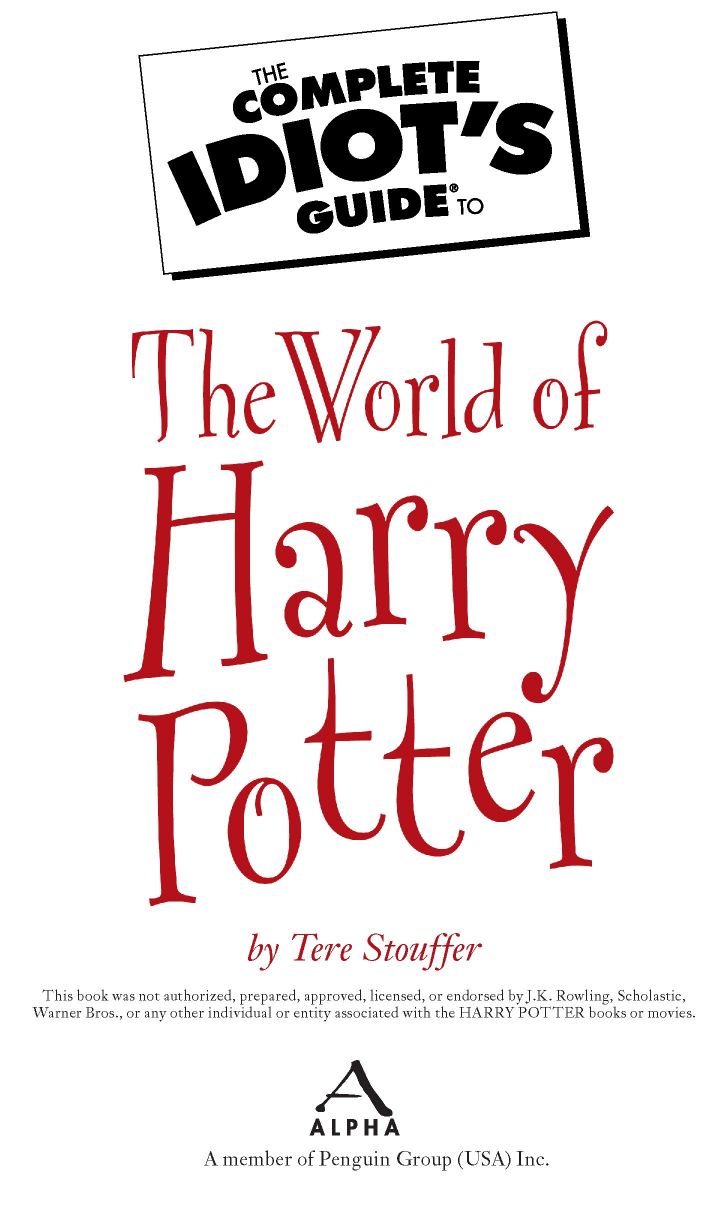The Complete Idiot's Guide to the World of Harry Potter
Read The Complete Idiot's Guide to the World of Harry Potter Online
Authors: Tere Stouffer


Table of Contents
ALPHA BOOKS
Published by the Penguin Group
Penguin Group (USA) Inc., 375 Hudson Street, New York, New York 10014, USA
Penguin Group (Canada), 90 Eglinton Avenue East, Suite 700, Toronto, Ontario M4P 2Y3,
Canada (a division of Pearson Penguin Canada Inc.)
Penguin Books Ltd., 80 Strand, London WC2R 0RL, England
Penguin Ireland, 25 St. Stephen’s Green, Dublin 2, Ireland (a division of Penguin Books Ltd.)
Penguin Group (Australia), 250 Camberwell Road, Camberwell, Victoria 3124, Australia (a
division of Pearson Australia Group Pty. Ltd.)
Penguin Books India Pvt. Ltd., 11 Community Centre, Panchsheel Park, New Delhi—110 017,
India
Penguin Group (NZ), 67 Apollo Drive, Rosedale, North Shore, Auckland 1311, New Zealand
(a division of Pearson New Zealand Ltd.)
Penguin Books (South Africa) (Pty.) Ltd., 24 Sturdee Avenue, Rosebank, Johannesburg 2196,
South Africa
Penguin Books Ltd., Registered Offices: 80 Strand, London WC2R 0RL, England
Published by the Penguin Group
Penguin Group (USA) Inc., 375 Hudson Street, New York, New York 10014, USA
Penguin Group (Canada), 90 Eglinton Avenue East, Suite 700, Toronto, Ontario M4P 2Y3,
Canada (a division of Pearson Penguin Canada Inc.)
Penguin Books Ltd., 80 Strand, London WC2R 0RL, England
Penguin Ireland, 25 St. Stephen’s Green, Dublin 2, Ireland (a division of Penguin Books Ltd.)
Penguin Group (Australia), 250 Camberwell Road, Camberwell, Victoria 3124, Australia (a
division of Pearson Australia Group Pty. Ltd.)
Penguin Books India Pvt. Ltd., 11 Community Centre, Panchsheel Park, New Delhi—110 017,
India
Penguin Group (NZ), 67 Apollo Drive, Rosedale, North Shore, Auckland 1311, New Zealand
(a division of Pearson New Zealand Ltd.)
Penguin Books (South Africa) (Pty.) Ltd., 24 Sturdee Avenue, Rosebank, Johannesburg 2196,
South Africa
Penguin Books Ltd., Registered Offices: 80 Strand, London WC2R 0RL, England
Copyright © 2007 by Tere Stouffer
All rights reserved. No part of this book shall be reproduced, stored in a retrieval system, or transmitted by any means, electronic, mechanical, photocopying, recording, or otherwise, without written permission from the publisher. No patent liability is assumed with respect to the use of the information contained herein. Although every precaution has been taken in the preparation of this book, the publisher and author assume no responsibility for errors or omissions. Neither is any liability assumed for damages resulting from the use of information contained herein. For information, address Alpha Books, 800 East 96th Street, Indianapolis, IN 46240.
THE COMPLETE IDIOT’S GUIDE TO and Design are registered trademarks of Penguin Group (USA) Inc.
International Standard Book Number: 978-1-59257-599-2
Library of Congress Catalog Card Number: 2007926846
Interpretation of the printing code: The rightmost number of the first series of numbers is the year of the book’s printing; the rightmost number of the second series of numbers is the number of the book’s printing. For example, a printing code of 07-1 shows that the first printing occurred in 2007.
The author and publisher specifically disclaim any responsibility for any liability, loss, or risk, personal or otherwise, which is incurred as a consequence, directly or indirectly, of the use and application of any of the contents of this book.
Most Alpha books are available at special quantity discounts for bulk purchases for sales promotions, premiums, fund-raising, or educational use. Special books, or book excerpts, can also be created to fit specific needs.
For details, write: Special Markets, Alpha Books, 375 Hudson Street, New York, NY 10014.
Publisher:
Marie Butler-Knight
Editorial Director:
Mike Sanders
Managing Editor:
Billy Fields
Acquisitions Editor:
Michele Wells
Development Editor:
Lynn Northrup
Production Editor:
Megan Douglass
Marie Butler-Knight
Editorial Director:
Mike Sanders
Managing Editor:
Billy Fields
Acquisitions Editor:
Michele Wells
Development Editor:
Lynn Northrup
Production Editor:
Megan Douglass
To J.K. Rowling, for giving us a reason
to stand in line at midnight, time and time again.
to stand in line at midnight, time and time again.
Contents at a Glance
Part 1: Wizards, Monsters, and Creatures of All Sorts 1
Chapter 1 Wizards, Witches, and Warlocks 3
Need to get up to speed on your wizard terminology and history? This chapter quickly sums up the terminology and famous wizards with which you need to be acquainted.
Chapter 2 Creatures of All Shapes and Sizes 19
From an acromantula to the yeti, this chapter explores the background, mythology, and literary connections of nearly fifty creatures in the wizarding world.
Part 2: Where and How the Wizards Are 43
Chapter 3 The Wizard’s Wardrobe and Toolbox 45
Robes, hats, wands, quills, and ink—what does it all mean? This chapter fills you in on the contents of the wizard’s toolbox.
Chapter 4 How Wizards Spend Their Days 61
The wizarding world is a whole new place, with its own money, mail system, entertainment, and food. This chapter gives you a tour of how typical wizards spend their days.
Chapter 5 Getting Around: Modes of Transportation 75
Whether traveling by broomstick or using a network of fireplaces, wizards travel by the simplest, cheapest methods in the world.
Chapter 6 The Sporting Life: Quidditch, Chess, and Other Games 85
This chapter gives you an inside look at wizard sports and games, many of which have a rich history: Quidditch; wizard-style chess; dueling, Gobstones, and card games.
Part 3: Magical Places 95
Chapter 7 Where the Witches Go in London 97
Isn’t it time you paid a visit to Diagon Alley and its dozen or more wizard stores? This chapter also introduces you to a few other London hotspots, including the wizard hospital.
Chapter 8 Hogwarts School and Hogsmeade 109
No reading, writing, and arithmetic are taught at Hogwarts School, but similarities to British boarding schools abound. In this chapter, you also pay a visit to Hogsmeade, the only all-wizard town in England.
Chapter 9 International Wizarding Schools 125
Well hidden from the prying eyes of Muggles, wizarding schools flourish all over the world. In this chapter, we visit two of these international academies.
Part 4: Spells, Potions, and Other Ways of Performing Magic 131
Chapter 10 Herbology 101 133
Before you can start to make potions, you have to know your herbs. This chapter gives you the botanical, literary, and mythological background on two dozen herbs used in the wizard world.
Chapter 11 Round About the Cauldron Go: Draughts and Potions 145
From love potions to truth serum, this chapter reviews the nomenclature and background of 25 potions used in the wizard world.
Chapter 12 Watch What You Say: Spells, Charms, Hexes, Jinxes, and Curses 163
Want to know more about wizard spells? This chapter shares dozens of charms, hexes, jinxes, spells, and curses, including the Latin, Greek, French, and Italian sources for many of their incantations.
Chapter 13 Advanced Wizardry 179
Eight advanced wizarding skills are discussed in detail here, from understanding prophecies to deciphering runes.
Part 5: Regulating Magic and the Wizards Who Perform It 191
Chapter 14 The Ministry of Magic 193
Like any good civilization, the wizarding world has a governing body that helps keep the peace. This chapter introduces you to the Ministry of Magic, pointing out both the similarities to and differences between it and the British government.
Chapter 15 Crime and Punishment 203
Some wizards do go bad, and the wizarding world has an effective way to deal with them. This chapter discusses how Aurors help keep the peace, and what happens to wizards guilty of serious crimes.
Chapter 16 The Final Word 213
The final novel wraps up the series and gives us additional spells and other delights. This chapter ties up loose ends and brings you up to speed, with the latest Potterisms and the language and history behind them.
Appendixes
A Glossary of British Terms 225
B Cool Wizarding Websites 233
Index 239
Introduction
The book you hold in your hands gives you an in-depth look at the world of Harry Potter in only 16 chapters. In these pages, you won’t find character sketches, plot summaries, or details about who said what on which page of which novel. Instead, you get to explore J.K. Rowling’s genius even more deeply, discovering the background of terminology, characters, places, and ideas throughout her novels.
Every detail created by Rowling has been researched to determine how she may have chosen that particular setting, that incantation for a spell, or that age-old symbol that has appeared in fantasy literature for centuries. Greek, Roman, and Celtic mythological similarities are explored. Latin, Greek, French, and Italian phrases are translated. Literary and Biblical characters are reintroduced, as are folk- and fairytale patterns. And comparisons to J.R.R. Tolkien’s
The Lord of the Rings,
C.S. Lewis’s
The Chronicles of Narnia,
Ursula Le Guin’s
Earthsea,
and other fantasy classics are made.
The Lord of the Rings,
C.S. Lewis’s
The Chronicles of Narnia,
Ursula Le Guin’s
Earthsea,
and other fantasy classics are made.
Along the way, you’ll recall details of the wizarding world that you may have forgotten, or, if you’ve never read the
Harry Potter
novels, you’ll have a chance to read them with informed eyes.
How to Use This BookHarry Potter
novels, you’ll have a chance to read them with informed eyes.
This book can be read cover to cover, or it can be used as a resource, reading only the chapters or sections on which you want to learn more about the wizarding world. If you want to get a complete education, sit down at Chapter 1 and read straight through. By the end of the book, you’ll not only have an excellent understanding of the origins and background of Rowling’s work but also a greater appreciation of the genius of her creativity. Few of the hundreds of names, incantations, and places in her novels were selected without a reason.
To use this book as a quick, get-in-get-out resource, flip to the Table of Contents or Index and start with your most pressing questions. From there, read only the chapters and sections that appeal to you. You’ll find that each chapter and section is self-contained and does not rely on your having read the section or chapters before.
This book is divided into five parts:
Part 1, “Wizards, Monsters, and Creatures of All Sorts,”
teaches you a little wizarding lingo, introduces the most famous wizards and witches, and gives you the scoop on creatures of all shapes and sizes.
teaches you a little wizarding lingo, introduces the most famous wizards and witches, and gives you the scoop on creatures of all shapes and sizes.
Part 2, “Where and How the Wizards Are,”
gets you acquainted with the way wizards live their everyday lives, from how they dress to what they eat to how they travel around town.
gets you acquainted with the way wizards live their everyday lives, from how they dress to what they eat to how they travel around town.
Part 3, “Magical Places,”
takes you on a tour of the wizarding hotspots in both London and Hogsmeade and gives you the lowdown on Hogwarts School and other wizard schools around the globe.
takes you on a tour of the wizarding hotspots in both London and Hogsmeade and gives you the lowdown on Hogwarts School and other wizard schools around the globe.
Other books
Rory's Glory by Justin Doyle
Glass Slipper by Abigail Barnette
The Tree In Changing Light by Roger McDonald
Royal Desire (Maid for the Billionaire Prince Vol 4) by Artemis Hunt
Elemental Earth (Paranormal Public) by Edwards, Maddy
Resurgence by Kerry Wilkinson
Floored by Paton, Ainslie
His Imperfect Mate 26 by Lynn Hagen
Beating Plowshares Into Swords: An Alternate History of the Vietnam War by Schaefer, F. C.
Fated: Karma Series, Book Three by Donna Augustine